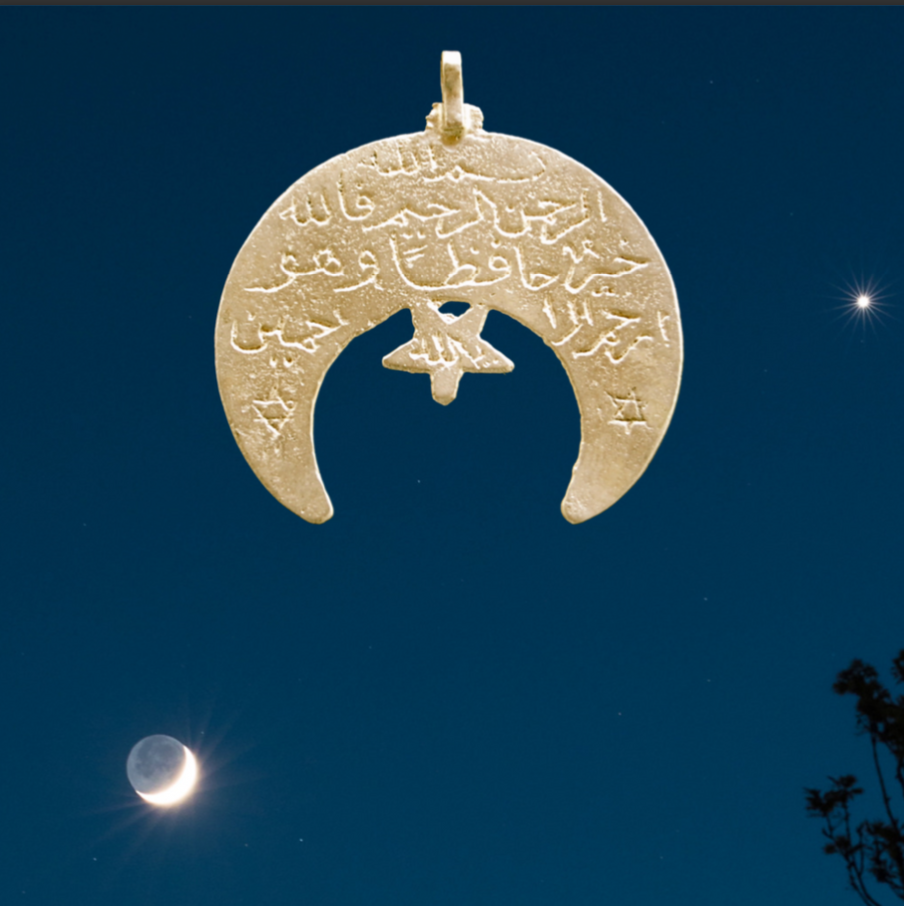The celestial bodies have been powerful symbols since antiquity. In ancient Mesopotamia and Egypt, studying the heavens was a highly developed art. It is therefore not surprising to find many references in jewellery, throughout the entire region, to the power of the skies.
This bracelet from Morocco is named ‘sun and moon’ because of its use of gold and silver
Sun and moon
This connection with the skies starts in the choice of materials. Silver, the preferred metal for jewellery, is strongly associated with the cool light of the moon, while gold is related to the heat of the sun. The moon has been important for women for millennia: not only is the lunar cycle of 28 days similar to a woman’s cycle, but the waxing and waning of the moon are associated with fertility. The crescent moon is often featured in jewellery, and in many other forms of visual expression. As one of the oldest symbols in the world, it is thought to bring growth and prosperity. Pendants in the shape of the crescent moon were already used in Roman times and continue to be worn today. The representation of the moon takes precedence over the sun: the latter is found not nearly as often in jewellery.
Omani plait ornament with crescent moon and star
Twinkling stars
Besides the sun and moon, stars are also a recurrent theme in jewellery. A familiar view is the crescent moon accompanied by a single star. One type of pendant with a crescent moon and a star is called
Hilal as-Shawwal. It visualizes the crescent moon that officially ends the month of
Ramadan
Ramaḍān: (Arabic), a name given to the ninth month of the Islamic calendar, observed by Muslims worldwide as a month of fasting. and ushers in the following month of Shawwal. Another explanation for the single star may be the appearance of Venus as the morning- or evening star. Although actually a planet, this shining point in the sky at dusk or dawn has accompanied the crescent moon in jewellery for centuries. A representation of the crescent moon with several stars is also often seen, for example on the well-known red glass beads produced in Bohemia for customers in the Middle East.
Five- or six-pointed stars are often employed together with a representation of the moon, and in Syria, Jordan and the Arab Peninsula, small pendants in the shape of crescents are found in abundance. The Seal of Salomo, a six-pointed star, is used throughout the entire region and is not just a Jewish symbol: it has been in use for centuries by all three main religions. It also features in magical inscriptions and formulae as a powerful symbol to ward off evil and to enhance spells.
A small pendant from Tunisia with a crescent moon, a six-pointed star on an ornament from Libya, the seven dots on a bracelet from Egypt and a ring with red glass from Oman, featuring the crescent and three stars
The skies and everyday life
The presence of the sun, moon and stars is not just because of symbolism, but also because they fulfilled a very practical role in everyday life. The night sky provided guidance for travel and the position of the heavenly bodies throughout the year announced the changing of seasons. One example of such an important star cluster is the Pleiades. This constellation, also known as the Seven Sisters or al-Thurayya in Arabic, has been extremely important for farming communities in the Middle East. The rising of this constellation in Morocco indicated the start of the planting season, and in Yemen, the Pleiades were used by farmers to keep track of the agricultural season. The widely used motif of a large disc and the smaller disc consisting of 7 dots is usually called the sun-and-moon-motif, but the seven dots could also be a reference to this star cluster. Given their importance connected to farming and sustenance, the Pleiades could very well be incorporated into jewellery design. As with so many other patterns, the representation of the skies in jewellery connects us with millennia of history and shares the stories of a way of living.
Where can I read more?
- Heavenly: Sun, Moon and Stars in Jewellery by Fritz Falk is a lovely introduction into celestial themes in jewellery across the globe.
- My book, Desert Silver, on which this post is based, discusses this theme as well.
*
Header image: An amulet from Syria in the shape of the crescent moon with a star



